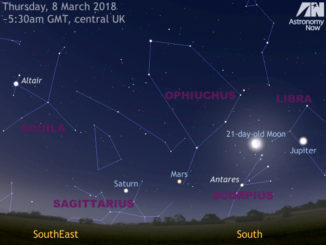
Aquila

Observing

Observing

Observing

Observing
Catch Mars and Venus in the early evening sky of late November
Find a location that offers you an unobstructed view of the horizon from south to southwest an hour after sunset. With clear skies, you’ll be able to follow Venus and Mars from night to night on their celestial peregrinations through the constellations of Sagittarius and Capricornus. The two planets almost keep pace with each other throughout the remainder of November.

Picture This
Hubble views face-on spiral galaxy NGC 6814
In this NASA/ESA Hubble Space Telescope image we see the striking face-on spiral galaxy NGC 6814, whose luminous nucleus and spectacular sweeping arms are rippled with an intricate pattern of dark dust. The galaxy was discovered by William Herschel in 1788. NGC 6814 lies 74.4 million light-years away in the constellation of Aquila.
